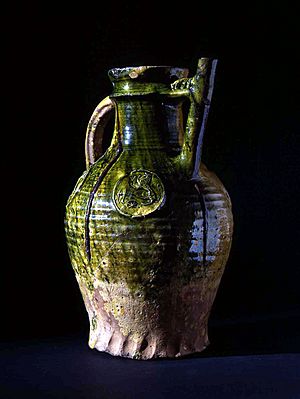York Glazed Ware facts for kids

York Glazed Ware is a special kind of pottery made a long time ago. It was created in North Yorkshire, England, during the 12th and 13th centuries. That's about 800 to 900 years ago! This pottery is known for its shiny, colorful surface.
Contents
Where Was York Glazed Ware Made?
You might think York Glazed Ware was made in York because of its name. But it was actually made about 30 miles north of York. The main place where it was produced was in the Hambleton Hills.
This pottery was made from the late 1100s to the mid-1200s. After that time, another type of pottery, called Brandsby-type ware, became more common.
What Is York Glazed Ware Made Of?
Even though it's sometimes called "white ware," the clay used for York Glazed Ware could be different colors. It might look light brown, light grey, or even pink.
The clay had a rough texture when broken. It often contained small bits of quartz rock. These tiny pieces of quartz sometimes had iron stains, making them look a bit rusty.
Shapes and Decorations of York Glazed Ware
York Glazed Ware was used to make many different items. Most often, people made jugs with it. Some of these jugs had special spouts that looked like tubes.
Other items included lids, cooking pots, and dishes for sauces. They even made interesting animal-shaped containers called aquamaniles, which were used for pouring water.
The potters added decorations in several ways:
- They put on extra pieces of clay.
- They carved designs into the clay.
- They used a tool to make patterns that looked like small wheels.
- They combed the surface to create lines.
One very special decoration was small clay pads. These pads were stamped with unique designs and then stuck onto the outside of large jugs.
The Shiny Green Glaze
The most striking thing about York Glazed Ware is its shiny surface. This is called a glaze. The glaze was usually a bright green color. Sometimes, it could be yellow. It often looked very glossy, almost like metal.
The green color came from adding a little bit of copper to the glaze. This copper could make the green color range from a light "apple green" to a very dark green. You might also see darker speckles in the glaze, which makes each piece unique.
See also
- History of Yorkshire
- Medieval York
- Brandsby-type ware
- Humber ware
- List of English medieval pottery

